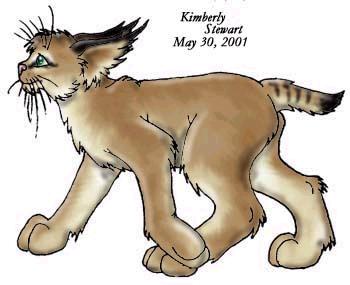
Tuft Cats




Description: These small felines of the desert stand about a foot high and couple feet in length (House cat size). They are covered with a dense fur that varies in color, mostly browns, tans and blacks. They have broad paws and a short tail ... they get their name from the tufts of hair on their broad ears. Their ears are wider then most cats and serves as fans to help cool. The ears can tell much about the Tuft Cat, when sleeping they relax and fold over their eyes ... when excited or interested they stand straight up ... when upset or angry they flatten against their head and neck.
Habitat: The Tuft Cat is unusual amongst the cat species in that it lives in organized social groups called troupes. The troupe can consist of as many as thirty to forty Tuft Cats the majority of which are females and their offspring along with a small number of resident males. It is common for the females within the troupe to be closely related and this family bonding is often extended through communal suckling and caring of the young within the group. The territory of the troupe is fixed and varies in size depending on the availability and distribution of prey.
The troupe lives in a commune of dens, which are usually found within the rocky walls of the cliffs. However, have also been known to burrow into the sand as well.
Hunting is also a shared process. Tuft Cats hunt small game animals such as dirt chicks, mice, and ravvits. Once the prey is killed it is brought back to the dens. Where it is common for the males of the troupe to eat first, then females are next to feed followed by the cubs - it is common, when prey is scarce, that the young will often starve as a result of being last in the pecking order for food.
Life-Cycle: Tuft Cat’s mating behavior is similar to a housecat's. Young are usually born in late spring, although litters may be born during almost any time except the dead of winter. The normal Tuft Cat litter consists of 2 or 3 kittens, born blind and weighing 4 to 8 ounces. The kittens open their eyes after 10 days and are taught hunting skills by their mother until they leave her 9 or 10 months later. The father has no role in raising the offspring. Males are usually fertile by their first year, but females do not usually give birth to their first litter until they are two years old. Females normally produce just one litter per year.
Tuft Cats have been known to live as long as 25 years ... however 15 to 20 years is about normal for those raised in the wild.
DesertWinds’ Troupe: Tuft Cats are very friendly and sociable and have been friends to the elves for generations. The current Troupe was living at the Oasis when the elves returned from their Wandering Years. It took some patience from the elves to get their Dune Dogs to let the felines share their space but now all is calm with the canines and the felines. They can even sometimes be seen playing and hunting together. Elves often adopt a Tuft Cat but most still choose to sleep with the troupe and return to their elf during the day.